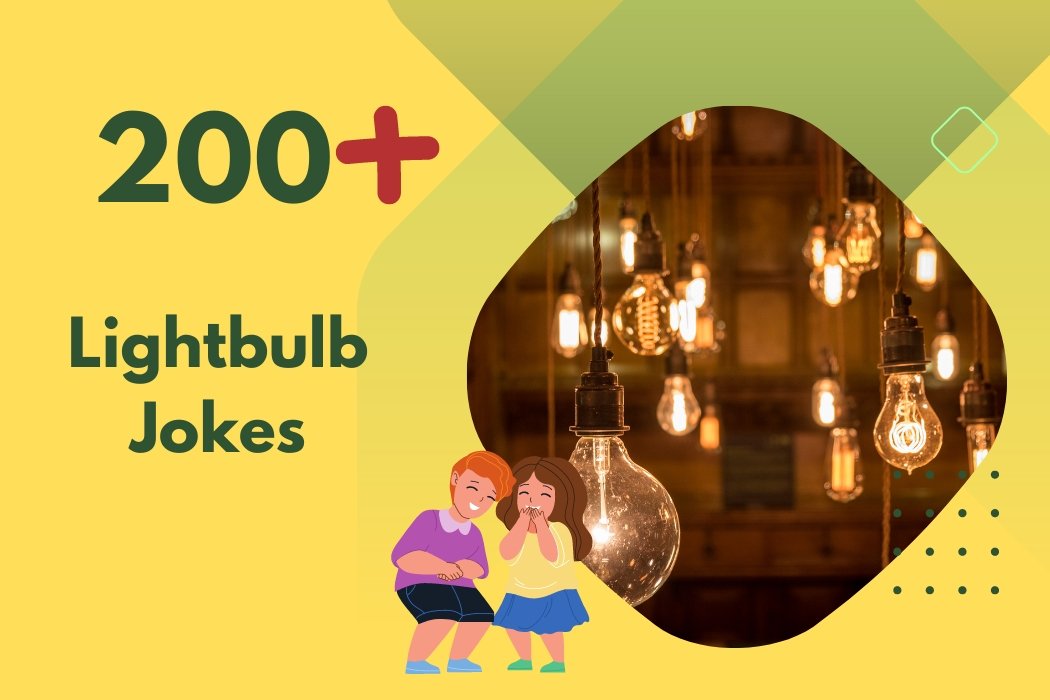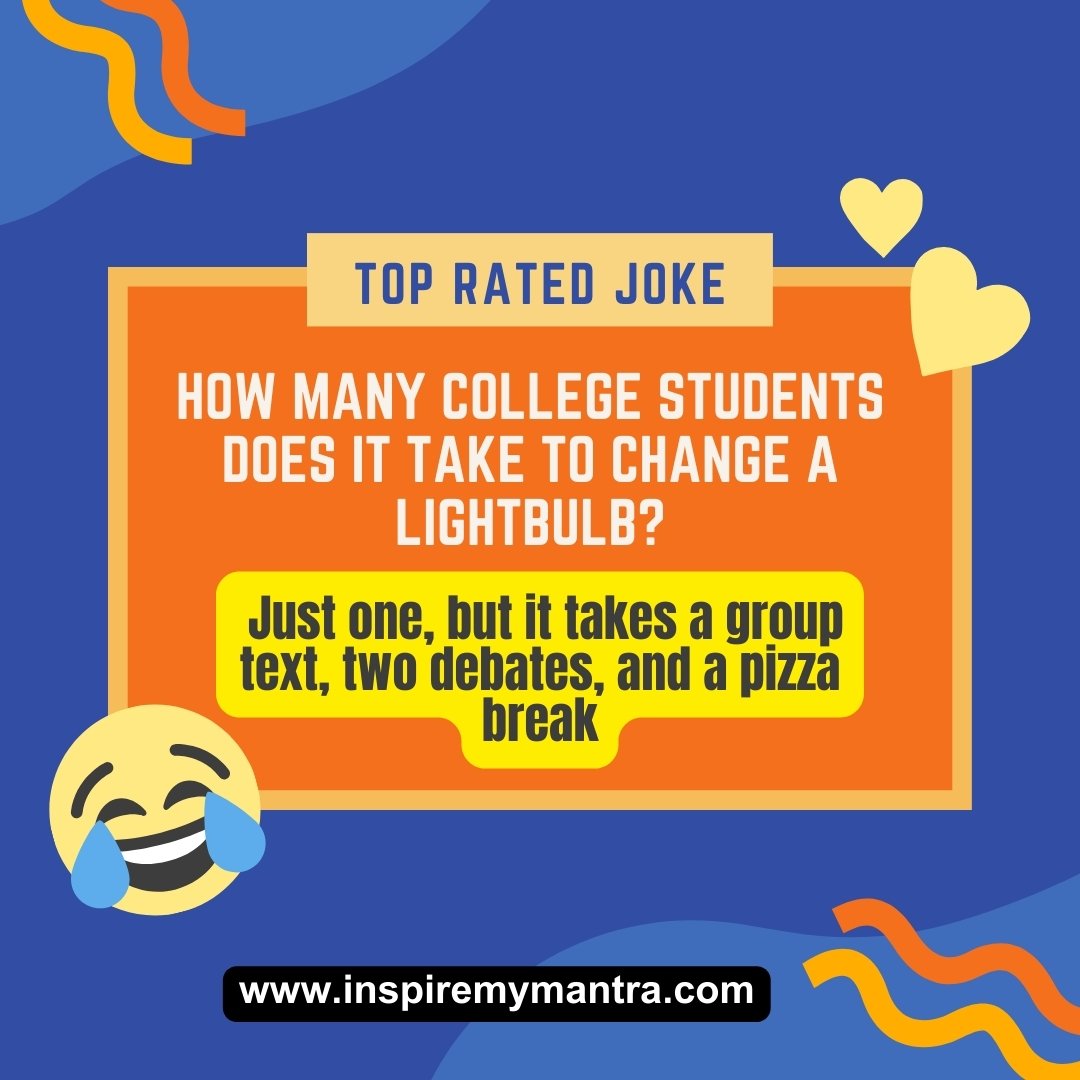
Lightbulb jokes, those quick, punchy setups with even punchier punchlines, tap into a universal form of humor that cuts across all demographics.
Why do these simple jokes, involving a mundane task like changing a lightbulb, captivate us so?
Could it be their ability to distill complex human behaviors, societal roles, and cultural idiosyncrasies into a few short lines?
By wrapping insightful observations in humor, lightbulb jokes illuminate more than just their immediate punchline—they shine a light on the quirks of human nature itself.
With their unexpected twists and turns, they offer a delightful mix of predictability and surprise, making us laugh while subtly nudging us to ponder the diversity of human thought and action.
Ready for a chuckle and perhaps a moment of reflection? Let’s explore the enduring charm and wit of lightbulb jokes.
College Lightbulb Jokes

How many college students does it take to change a lightbulb? Just one, but it takes a group text, two debates, and a pizza break.
A philosophy major asked, “Why change the lightbulb when we can question its existence?”
Engineering students don’t change lightbulbs; they automate the process.
Psychology majors: one, but the lightbulb must want to change.
Art students do it creatively, with a lightbulb that doesn’t quite fit.
Business majors calculate how changing the lightbulb will boost their resume.
Computer science majors: “Error 404, lightbulb not found.”
History majors know who invented the lightbulb but can’t change it.
Literature majors write an analysis of the lightbulb’s symbolism.
Math majors are still calculating the most efficient method.
Biology majors: Only if they can dissect the lightbulb afterward.
Communication majors get someone else to do it through persuasive speech.
Sociology majors explore the lightbulb’s impact on group dynamics.
Music majors compose a piece inspired by the act of changing it.
Environmental science majors find a sustainable, eco-friendly lightbulb.
Political science majors debate the policy implications of lightbulb changing.
Theatre majors perform a dramatic reenactment of the changing.
Nursing students do it with care, ensuring the lightbulb’s safety.
International relations majors find a lightbulb that promotes global harmony.
Education majors teach someone else how to do it.
Geography majors find the most culturally appropriate lightbulb.
Astronomy majors wait for a star to do it.
Anthropology majors study the cultural significance of lightbulb changing.
Journalism majors report on the groundbreaking change.
Culinary students bake a cake shaped like a lightbulb instead.
Fashion majors ensure the new lightbulb is aesthetically pleasing.
Film students make a documentary on the evolution of lightbulbs.
Economics majors assess the cost-benefit analysis first.
Physical education majors do it as part of their workout.
Public health majors ensure everyone washes their hands afterward.
Forensic science majors investigate what caused the old one to burn out.
Graphic design majors create a visually appealing lightbulb package.
Social work majors support the lightbulb in its time of need.
Veterinary students make sure no animals are scared of the dark.
Linguistics majors describe the process in ten different languages.
Urban planning majors design a city where no lightbulb ever needs changing.
Marine biology majors only if it’s underwater.
Philosophy majors debate if the lightbulb perceives itself as changed.
Chemistry majors try to invent a new kind of lightbulb.
Hospitality majors make sure everyone is comfortable during the process.
Screw In A Lightbulb Jokes

Why did the smartphone bring a ladder? To update its software with better light.
Ghosts never change lightbulbs. They like it spooky dark.
Why did the sun skip the lightbulb changing? It shines brighter anyway.
Time travelers don’t change them; they already attended the switch-on ceremony.
Cats don’t bother. They can see in the dark, remember?
Aliens inquire, “Why not just use bioluminescence?”
Robots calculate the most efficient twist but lack the hands.
Superheroes wait for a blackout to save the day.
Wizards conjure light without bulbs. Much more magical.
Pirates search for bulbs buried as treasure.
Detectives find who did it in the dark.
Dragons offer to light up rooms. No bulbs needed.
Vampires ask, “Why would we want it bright?”
Knights joust for the honor to screw in the light.
Zombies try but keep forgetting why.
Elves craft an enchanted light, no electricity required.
Dinosaurs couldn’t do it. Arms too short.
Astronauts change them in zero gravity, floating fun.
Cowboys lasso the old bulbs down.
Mermaids would, if they had any dry sockets.
Ninjas change it without anyone seeing.
Bakers cook up a lightbulb-shaped cake instead.
Clowns juggle them but never get to changing.
Magicians make the old bulb vanish first.
Teachers quiz on the best way to change it.
Scientists develop a bulb that never goes out.
Snowmen wait for a warmer bulb.
Racecar drivers do it in record time.
Bankers invest in long-lasting LED bulbs.
Gardeners plant a bulb and wait for it to grow light.
How Many To Change A Lightbulb Jokes
How many cats to change a lightbulb? None. They prefer the shadows.
How many bookworms? One, but they’ll read the manual cover to cover first.
How many procrastinators? They’ll get to it eventually.
How many perfectionists? Only one, but they’ll go through ten bulbs to find the perfect fit.
How many minimalists? None. They don’t have extra bulbs.
How many optimists? Just one, but they believe in the power of light.
How many pessimists? Why bother? It’ll just burn out again.
How many adventurers? Two. One to change it, one to tell the tale.
How many comedians? One, but they’ll turn it into a whole routine.
How many skeptics? They don’t believe the bulb needs changing.
How many techies? They automate it. No humans needed.
How many chefs? One, but first, they’ll whip up a snack.
How many kids? Three. One to hold the bulb, two to turn the ladder.
How many gamers? They’re too busy leveling up to notice the dark.
How many gardeners? One, but they’ll plant a flower under it for good measure.
How many musicians? Four. One to change it, three to harmonize about it.
How many poets? One, to describe the light in verses.
How many athletes? Two. One for the job, one for the motivational speech.
How many historians? They prefer candlelight.
How many tourists? Just one, but they’ll take photos from all angles.
How many scientists? They’ll first calculate the bulb’s lifespan.
How many inventors? One to create a bulb that never needs changing.
How many linguists? One, to explain it in multiple languages.
How many extroverts? A whole party, for the fun of it.
How many introverts? One, but honestly, they’d rather not.
How many philosophers? They wonder if the bulb perceives itself as bright.
How many cyclists? One, but they’ll make a journey of it.
How many environmentalists? One, but only if the bulb is eco-friendly.
How many clairvoyants? They knew you’d ask that.
How many writers? One, but they’ll draft several endings first.
Ivy League Lightbulb Jokes
Harvard students form a think tank to innovate a self-changing lightbulb.
Yale students debate the ethical implications of lightbulb labor.
Princetonians design an aesthetically superior lightbulb before changing it.
Columbia students write a thesis on the history of lightbulb evolution.
Brown students insist on a community consensus before deciding on the change.
Dartmouth students embark on a wilderness retreat to learn from natural light first.
Cornellians engineer a more efficient, sustainable lightbulb.
Penn students calculate the ROI of changing the bulb themselves versus outsourcing.
Harvard law students argue who holds the legal responsibility for the change.
Yale psychologists analyze how the lightbulb feels about being changed.
Princeton architects draft a new room that doesn’t need lightbulbs.
Columbia journalists report on the changing, turning it into a national story.
Brown philosophers ponder if the lightbulb truly wants to change.
Dartmouth athletes turn the task into a team-building exercise.
Cornell agronomists grow a plant that glows, replacing the need for bulbs.
Penn med students research the effects of LED vs. incandescent on eye health.
Harvard entrepreneurs pitch a startup based on revolutionary lightbulb technology.
Yale musicians compose an ode to the departed filament.
Princeton’s rowing team changes it in sync, as a practice in teamwork.
Columbia filmmakers produce a documentary on the life of a lightbulb.
Brown ecologists search for a bulb that impacts the environment the least.
Dartmouth chefs prepare a candlelit dinner to avoid changing the bulb.
Cornell astronomers develop a room illuminated by starlight.
Penn historians create a timeline of all the bulbs ever changed on campus.
Harvard mathematicians prove the efficiency of changing bulbs in groups of three.
Yale linguists translate the instructions into twelve languages for practice.
Princeton computer scientists develop an app for tracking bulb life.
Columbia environmentalists start a campaign for solar lighting.
Brown activists host a workshop on energy justice through lightbulb choices.
Dartmouth comedians turn the entire process into a stand-up routine.






